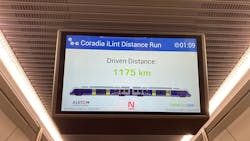Alstom’s hydrogen-fueled Coradia iLint train completes 1,175km journey without refueling
Alstom demonstrated the effectiveness of its Coradia iLint train, covering a distance of 1,175 km (730 miles) without refuelling its hydrogen tank. The firm used a vehicle from the fleet belonging to the transport authority of Lower Saxony, Landesnahverkehrsgesellschaft Niedersachsen (LNVG), for this demonstration project.
The vehicle, used for the journey from Lower Saxony to Bavaria through Hesse, has been in regular operation on the Eisenbahnen und Verkehrsbetriebe Elbe-Weser GmbH network since the middle of August 2022. Alstom also partnered with Linde, a gas and engineering firm, for this project.
“We are pleased to be leading innovation in this area as the first railway manufacturer in the world to offer a passenger train based on hydrogen technology. With this journey, we have provided further proof that our hydrogen trains have all the prerequisites to replace diesel vehicles,” said Henri Poupart-Lafarge, CEO and Chairman of the Board at Alstom.
Alstom has a contract for 14 Coradia iLint trains with LNVG and has also been commissioned to supply 27 of the trains for the Frankfurt metropolitan area. Additionally, Alstom is building 6 Coradia Stream hydrogen trains for Lombardy, Italy, with an option for eight more of the vehicles.
About the Author
EnergyTech Staff
Rod Walton is senior editor for EnergyTech.com. He has spent 17 years covering the energy industry as a newspaper and trade journalist.
Walton formerly was energy writer and business editor at the Tulsa World. Later, he spent six years covering the electricity power sector for Pennwell and Clarion Events. He joined Endeavor and EnergyTech in November 2021.
He can be reached at [email protected].
EnergyTech is focused on the mission critical and large-scale energy users and their sustainability and resiliency goals. These include the commercial and industrial sectors, as well as the military, universities, data centers and microgrids.
Many large-scale energy users such as Fortune 500 companies, and mission-critical users such as military bases, universities, healthcare facilities, public safety and data centers, shifting their energy priorities to reach net-zero carbon goals within the coming decades. These include plans for renewable energy power purchase agreements, but also on-site resiliency projects such as microgrids, combined heat and power, rooftop solar, energy storage, digitalization and building efficiency upgrades.
